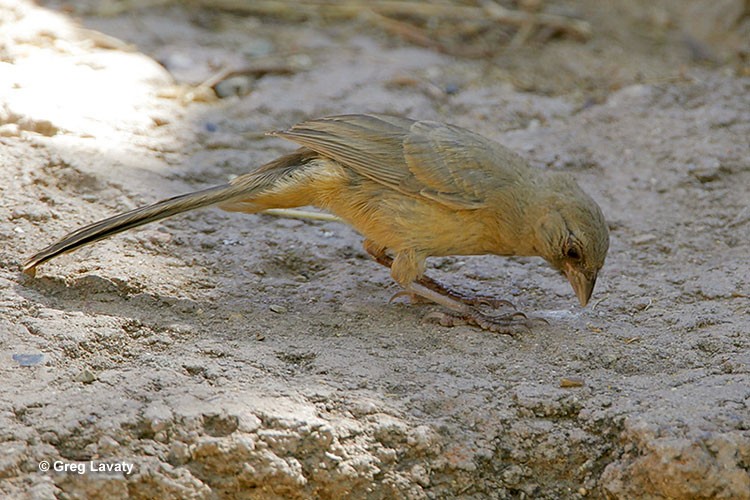This desert towhee visits backyard water features in Arizona and a few other places. The Abert’s Towhee is a large, robin-sized sparrow with sandy, gray-brown plumage and a bit of black on its face.
This bird forages on the ground in brushy, streamside habitats in the Sonoran Desert. It can be seen in Arizona, the southeastern corner of California, near Las Vegas, Nevada, and small parts of Utah, New Mexico, and Mexico.
If you see a big, grayish-brown sparrow with a dark face in the deserts of Arizona, you have found an Abert’s Towhee. These unique sparrows are common in brushy vegetation along waterways and are often seen in backyards in most of their range.
Identification
The Abert’s Towhee is a large sparrow nearly as big as an American Robin. On average, this towhee is 9.5 inches long, has a wingspan of 11 inches, and weighs 1.6 ounces.
Male and female Abert’s Towhees look the same although males tend to be slightly larger and heavier. Both sexes have plain, ashy or sandy grayish-brown plumage with a hint of cinnamon highlights on their chest.
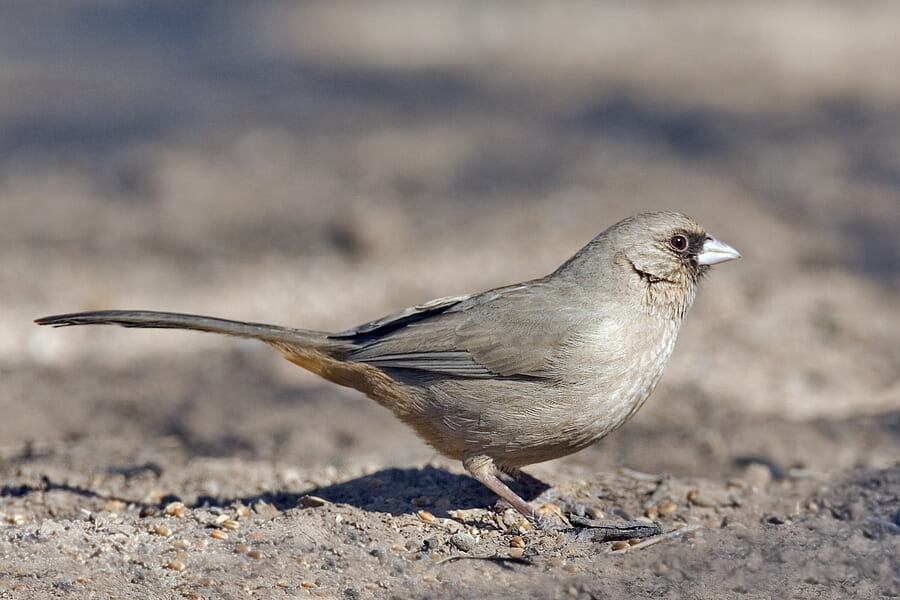
They have black around their eyes, and a bit of black on their face and chin. This towhee species also has a pale, pinkish-gray, conical beak, and can show a hint of a crest.
The other main field mark for this plain bird is its reddish-brown undertail. Juveniles look like adults but have smaller beaks and some blurry streaks on their underparts.
The Abert’s Towhee has a longish, dark tail with a rounded tip, and rather short, rounded wings.
This bird doesn’t fly very often but when it does, it flies low with a burst of rapid wingbeats and glides.
Abert’s Towhees make soft “seep” calls, and pairs often make a descending, squealing vocalization together. Males sing a basic song of repeated “tink” calls and also sing a short song that sounds like, “pink pink pink pink chachachacha”.
Food
The Abert’s Towhee feeds on a variety of insects and some seeds. Most of its diet is comprised of insects. Unlike several other species that switch from eating insects to mostly feeding on fruits and seeds in the winter, insects form the largest part of this bird’s diet all year long.
Abert’s Towhees eat many beetles, cicadas, caterpillars, ants, and most other insects they manage to find in their desert habitat. They forage for arthropods by using both legs to scratch in leaf litter and other bits of vegetation on the ground.
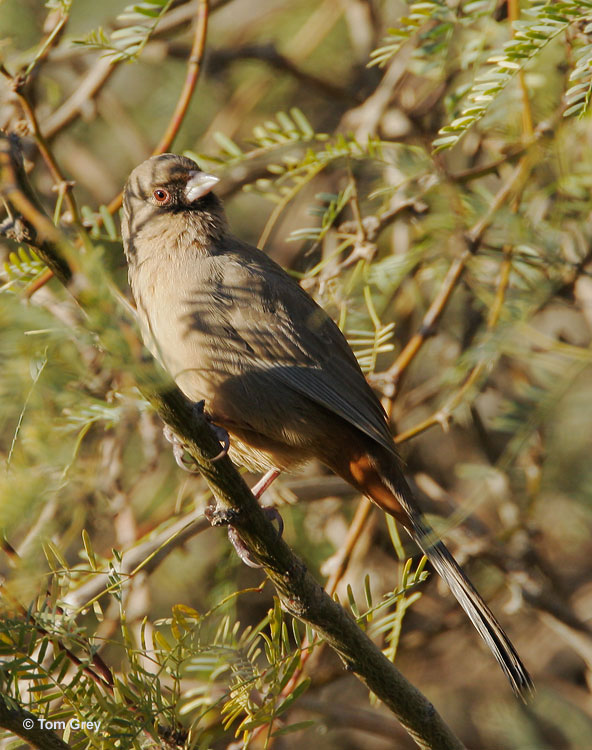
Moving leaves like this reveals hidden insects and scares bugs into the open. When the towhee sees an insect, it quickly moves in to snatch it with its beak.
Once in a while, this species can also forage for insects in bushes and on tree trunks and branches. When foraging like this, it usually picks bugs from hiding places in the bark.
These birds forage for the seeds of grasses, Saltbush, and some other plants by picking them off the ground. Cracked corn and other seeds placed on the ground can attract the Abert’s Towhee to a backyard feeding station. They will also visit to take advantage of water features.
Nesting and Eggs
The female Abert’s Towhee builds her nest in dense vegetation, usually during March or April. She makes a rather bulky cup nest out of leaves, bark, grass, and twigs, mostly using vegetation from the brushy, gallery woodlands preferred by this species.
Her nest is usually five to seven feet above the ground and can also be built in dense Mistletoe bushes. The nest site’s most important attribute is dense vegetation high enough to provide some protection from predators, and thick enough to help shade and cool off the eggs and young birds.
The cup part of the Abert’s Towhee nest is three inches across and around one and a half inches deep. She takes around a week to build the nest and once it’s complete, she lays one to four eggs.
They are pale blue-gray with dark markings on the wider end of the egg, are one inch long, and weigh .15 ounces. The female Abert’s Towhee incubates her eggs for two weeks and the nestlings stay in the nest for 12 to 13 days more. During that time, both parents feed their young and continue to bring food and protect them for at least a month after they leave the nest.
Current Situation
Abert’s Towhees are permanent residents of the Sonoran Desert in Arizona, the southeastern corner of California, southern Nevada, and small parts of Utah, New Mexico, and Mexico. They live in gallery woodlands, and brushy areas along waterways and in many urban areas.
This species is listed as Least Concern in the IUCN Red List and is not considered to be threatened.
The Abert’s Towhees is a common bird with an estimated population of 950,000. However, researchers suspect that it used to be even more common when there was a lot more gallery forest in its range. Much of this habitat has been converted to agriculture or grazing and is no longer suitable for the Abert’s Towhee. Fortunately, smaller numbers can still live in brushy habitats in urban areas.
Since the Abert’s Towhee has a small range, if more gallery woodlands and brushy areas are cleared, it could eventually become threatened.
Facts
- Abert’s Towhees form permanent pairs so they can quickly take advantage of optimal nesting conditions brought on by unpredictable rains in their desert habitat.
- The Abert’s Towhee gets its common English name from Lt. Col. James William Abert. He was a U.S. Army officer in the Topographical Engineers who obtained the first a scientific specimen of this bird on a survey in New Mexico during the late 1800s.
- DNA studies have shown that the closest relative of the Abert’s Towhee is the California Towhee. This was a surprise because this bird looks just like the Canyon Towhee. However, one of the Abert’s Towhee’s songs also sounds similar to the California Towhee.
- The Abert’s Towhee has one of the smallest ranges of any bird in North America. Most of its breeding range is also restricted to the USA. This species barely ranges into small areas in northern Mexico.
- Abert’s Towhees are very territorial. Pairs chase other towhees, cardinals, and other sparrow species away from their territory. They probably evolved this behavior to defend scarce food sources in their arid environment.
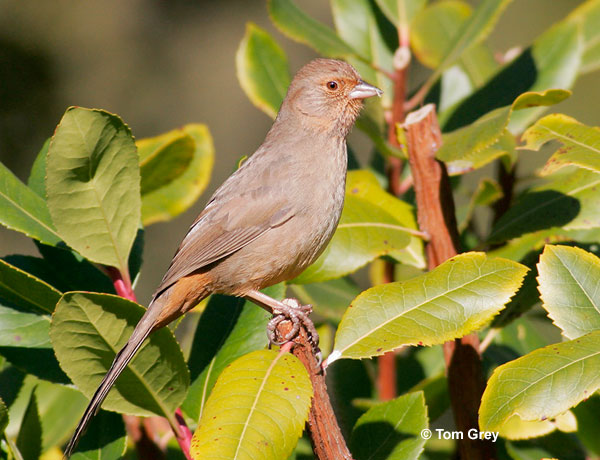
DNA studies have shown that the closest relative of the Abert’s Towhee is the California Towhee (in picture)
Similar Species
The Abert’s Towhee is a distinctive bird but it could be potentially confused with a few other bird species. However, with a good look, all Abert’s Towhees can be identified by the combination of plain gray-brown plumage, pale beak, black on their face, and red-brown undertail.
Canyon Towhee (and California Towhee)
The Canyon Towhee lives in some of the same areas as the Abert’s Towhee. Much of its plumage is similar but it lacks black on its face and chin, and has a darker beak. The California Towhee has the same plumage as the Canyon Towhee but doesn’t live in the same areas as the Abert’s Towhee.
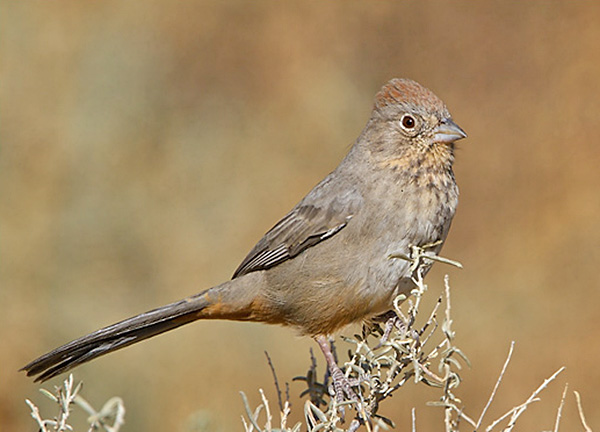
Canyon Towhee (Pipilo fuscus) perched on a branch near the Bosque del Apache wildlife refuge near Socorro, New Mexico, USA.
Black-chinned Sparrow
This sparrow has black on its face and a pale beak a bit like an Abert’s Towhee. However, it is darker gray and has a contrasting, streaked brown back and wings. This sparrow also breeds at slightly higher elevations.
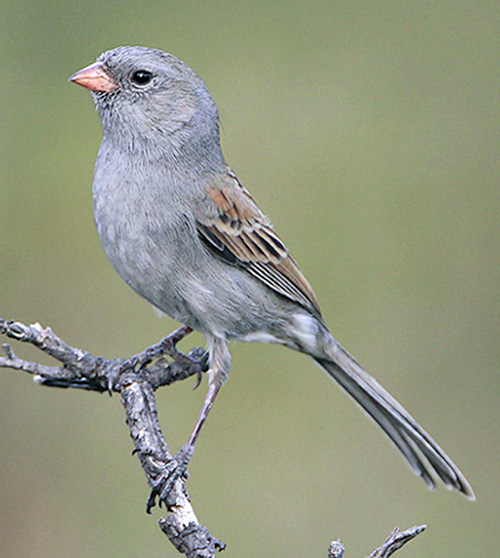
Black-chinned Sparrow. Photograph © Greg Lavaty.
Rufous-crowned Sparrow
The Rufous-crowned Sparrow has somewhat similar gray-brown coloration but has a contrasting red-brown crown. It also has a white eyering and dark beak, and lacks black on its face. This species also usually occurs at slightly higher elevations.
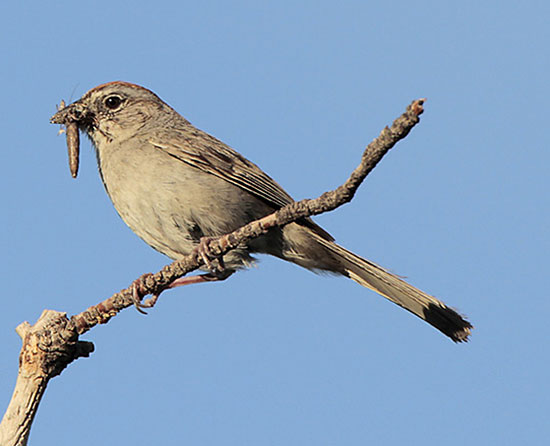
Rufous-crowned Sparrow
FAQ
Who was Abert’s Towhee named after?
Abert’s Towhee was named after Lt. Col. James William Abert. This naturalist found the first scientific specimen of the Abert’s Towhee in the 1800s.
What do Abert’s Towhee eat?
Abert’s Towhee eats a wide variety of insects. They also eat some seeds but mostly feed on insects found underneath dense, brushy habitats.
What family are towhees in?
Towhees are in the “New World Sparrow” family, or the “Passerellidae”. Other members of this bird family include the Tree Sparrow, juncos, and the Lark Bunting.

